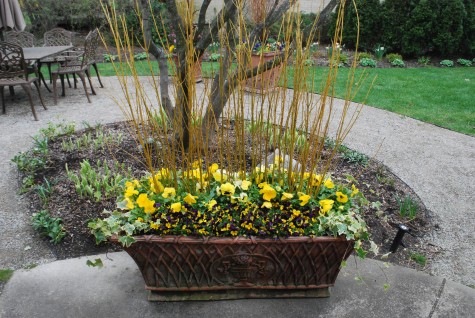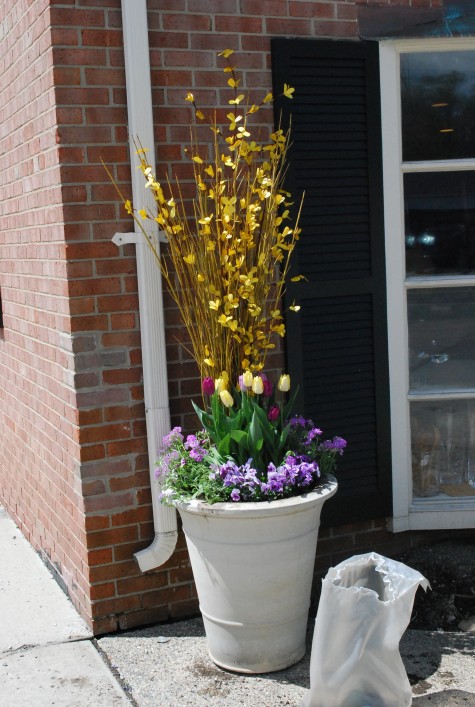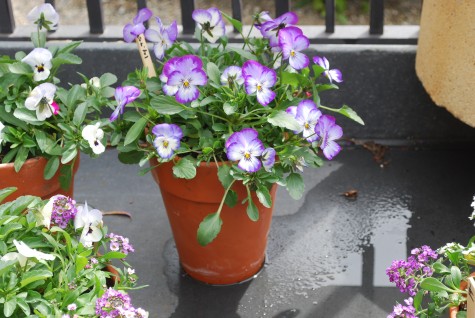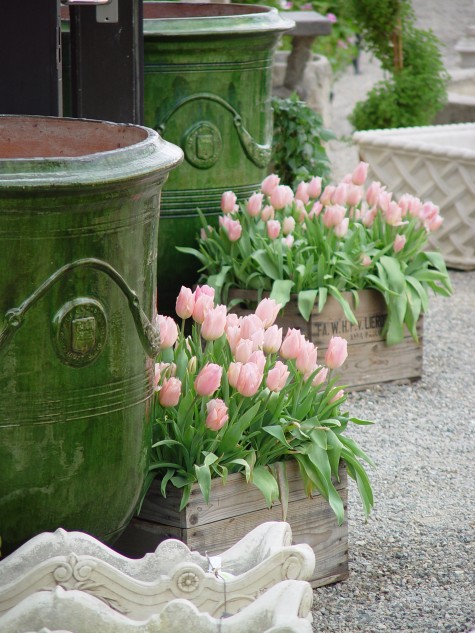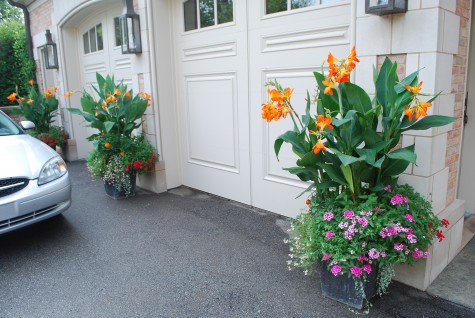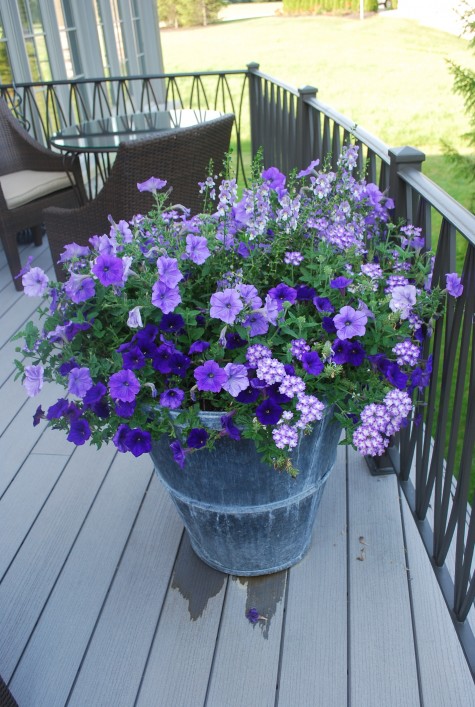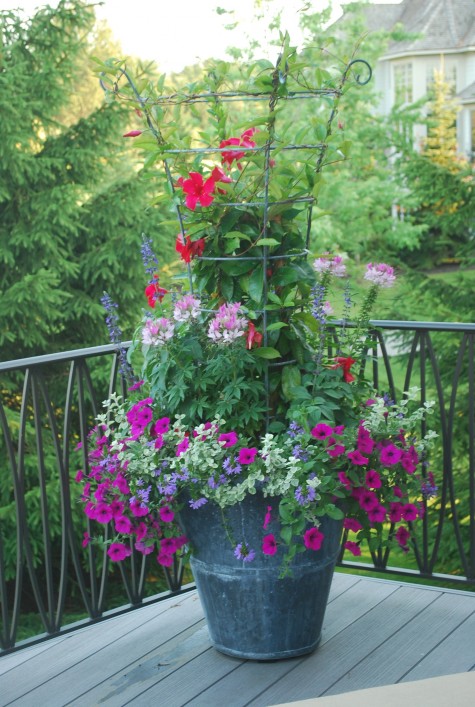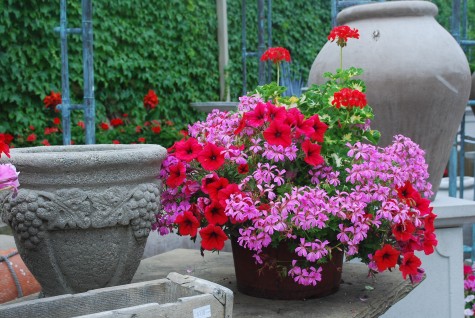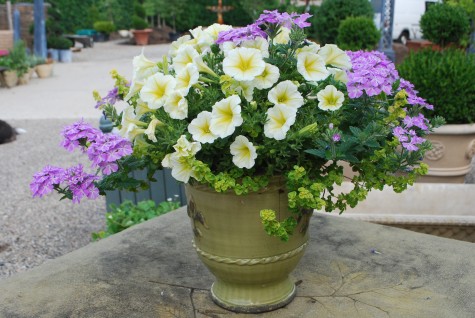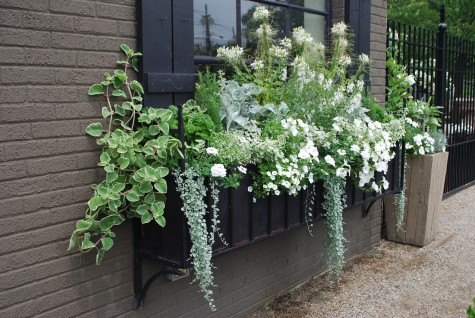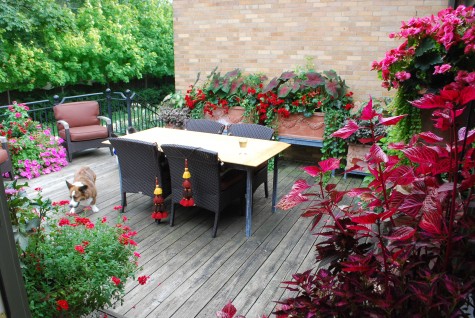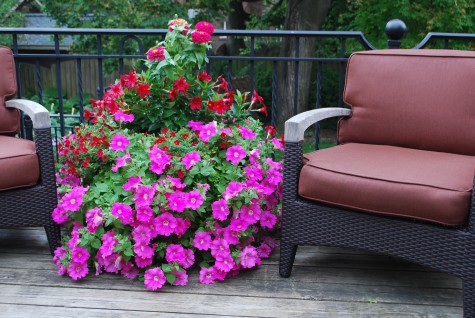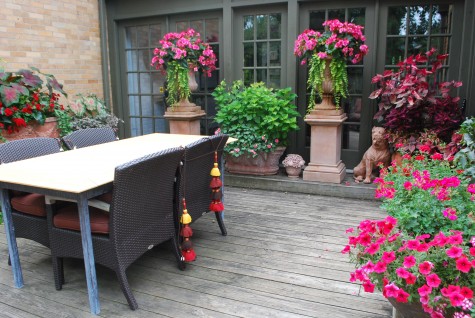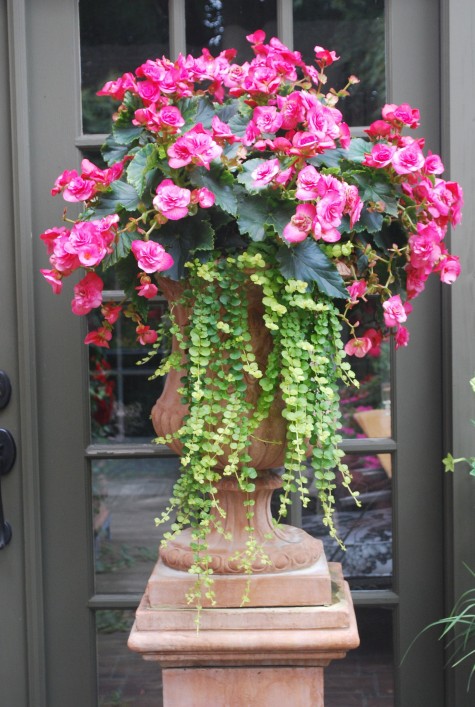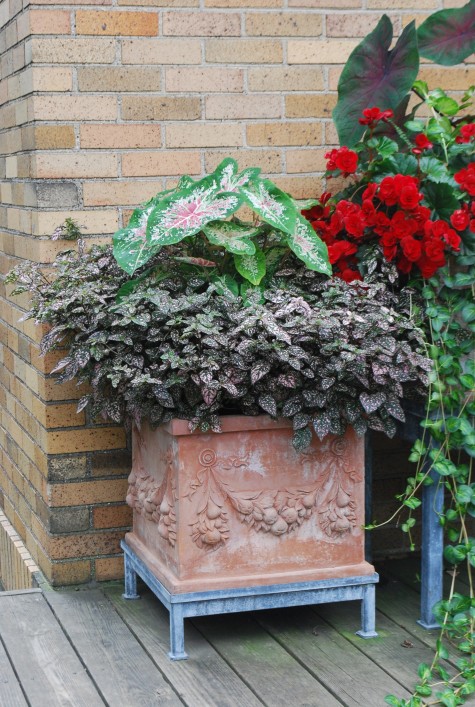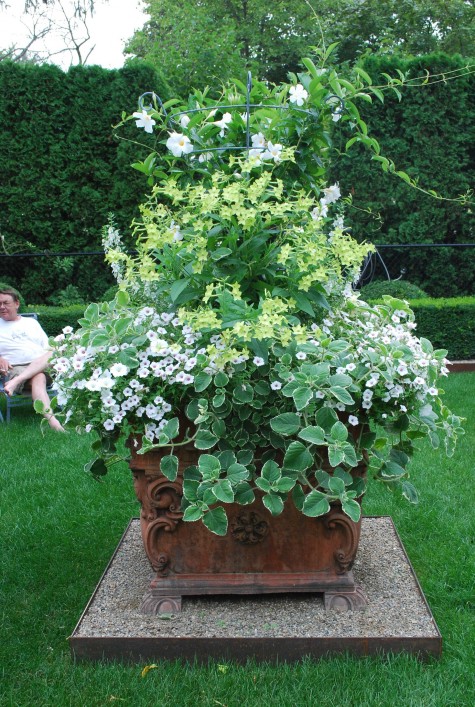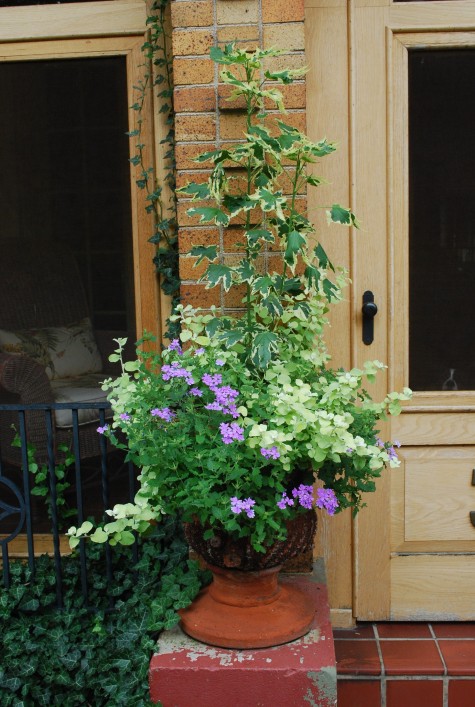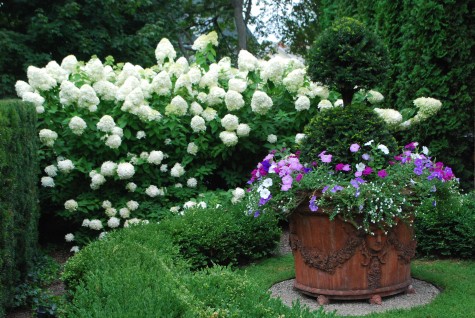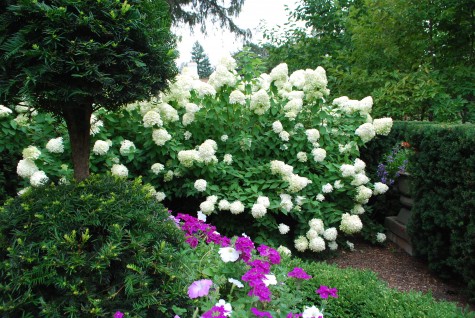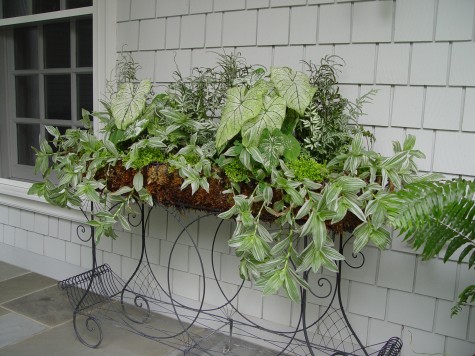 Containers planted with an all green color scheme can be very beautiful. Eliminating color as an element in container design means that other elements, such as texture, mass, form, scale, and proportion, become very much more important. The frosty white Victorian parlor ferns in this planter are a lacy contrast to the big leaves of the white caladiums. The languid and lax habit of the tradescantia fl. Variegata contrasts to the tight soil skimming habit of the lime green club moss, known as selaginella. Overall, the planting is loose, and airy-just like the container. The container itself is such an important element of the overall composition.
Containers planted with an all green color scheme can be very beautiful. Eliminating color as an element in container design means that other elements, such as texture, mass, form, scale, and proportion, become very much more important. The frosty white Victorian parlor ferns in this planter are a lacy contrast to the big leaves of the white caladiums. The languid and lax habit of the tradescantia fl. Variegata contrasts to the tight soil skimming habit of the lime green club moss, known as selaginella. Overall, the planting is loose, and airy-just like the container. The container itself is such an important element of the overall composition.
 I planted this pair of Italian pots with 2 gallon size zebra grasses, and finished up all around with lime variegated plectranthus. The colors in one plant mirror the colors of the other-so all of the visual interest is the contrast of the tall narrow grass blades, and the thick felted trailing leaves of the plectranthus. I pinched the plectranthus, which is related to coleus, all summer long. This made for an overall shape that was widely horizontal. The tall grass, in contrast to the very wide plectranthus-a certain visual contrast that satisfied my eye. The glimpse I still see of the pot at the bottom is just enough to complete the picture. The planting does a good job of describing what the planter looks like, though you cannot see so much of it. This is a very simple planting which to my eye is very visually engaging.
I planted this pair of Italian pots with 2 gallon size zebra grasses, and finished up all around with lime variegated plectranthus. The colors in one plant mirror the colors of the other-so all of the visual interest is the contrast of the tall narrow grass blades, and the thick felted trailing leaves of the plectranthus. I pinched the plectranthus, which is related to coleus, all summer long. This made for an overall shape that was widely horizontal. The tall grass, in contrast to the very wide plectranthus-a certain visual contrast that satisfied my eye. The glimpse I still see of the pot at the bottom is just enough to complete the picture. The planting does a good job of describing what the planter looks like, though you cannot see so much of it. This is a very simple planting which to my eye is very visually engaging.
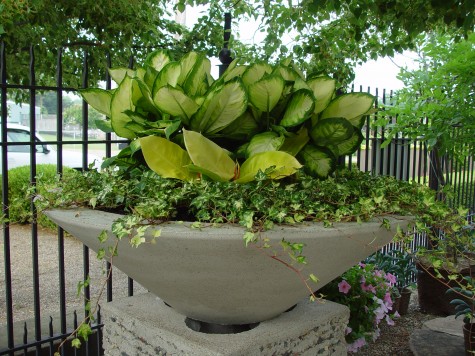 Big leaves-do you not love them? This severely contemporary v-shaped limestone planter benefits from a planting of the paddle-leaved tropical plant dieffenbachia. The pale yellow green leaves can dramatically lighten a very shady spot. The yellow variegated ivy once established, I kept trimmed to the inside edge of the stone, as the container itself makes such a strong statement. The overall shape of the planting seems pleasing to me. This planting greatly complements the container.
Big leaves-do you not love them? This severely contemporary v-shaped limestone planter benefits from a planting of the paddle-leaved tropical plant dieffenbachia. The pale yellow green leaves can dramatically lighten a very shady spot. The yellow variegated ivy once established, I kept trimmed to the inside edge of the stone, as the container itself makes such a strong statement. The overall shape of the planting seems pleasing to me. This planting greatly complements the container.
 This planter located on a city street got planted with a lime green version of dawn redwood-a lime green version of Metasequoia. Small trees can be great in containers; they can be planted in the ground at the end of the summer season. The fiber optic grass and Scotch moss are just about the same shade of green. This planting is simply about texture, and plant habit. The relationship of one plant to another is enough to keep me gardening.
This planter located on a city street got planted with a lime green version of dawn redwood-a lime green version of Metasequoia. Small trees can be great in containers; they can be planted in the ground at the end of the summer season. The fiber optic grass and Scotch moss are just about the same shade of green. This planting is simply about texture, and plant habit. The relationship of one plant to another is enough to keep me gardening.
 The lime green dracaena Jenny Craig is another great tropical plant suitable for containers in shady places. The strappy leaves cascade like water from a fountain. The variegated licorice petticoat pictured above provides some width that helps to balance the composition. The detail of the urns is still visible. I spend a lot of time picking and choosing what of a container gets hidden by draping plants-and what stays exposed.
The lime green dracaena Jenny Craig is another great tropical plant suitable for containers in shady places. The strappy leaves cascade like water from a fountain. The variegated licorice petticoat pictured above provides some width that helps to balance the composition. The detail of the urns is still visible. I spend a lot of time picking and choosing what of a container gets hidden by draping plants-and what stays exposed.
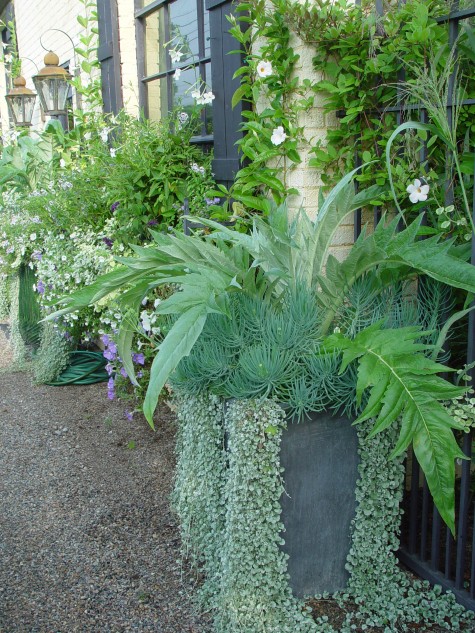 This cardoon is a very architecturally striking plant. The leaves have a prehistoric, slightly menacing look about them. They have an aura which is so strong-they have the visual power to organize a space. The blue green succulent planted at its base-I have no idea what this is called-sorry. My eyes and my instincts just told me they would work in this container. These succulents do a great job of softening the look of the cardoon-even though the foliage is stiff, and needle-like. The silver falls dichondra drapes down the corners of this lead container, and puddles on the ground-a languid, and gorgeous contrast to those stiff cardoon leaves. In general, it is easier to achieve a balanced compostion with three elements, as opposed to two. A container with one or two elements will need thoughtful work on the shaping as it grows, to keep the arrangement visually interesting. A single well cared for topiary plant in a pot would be a good example of this kind of grooming.
This cardoon is a very architecturally striking plant. The leaves have a prehistoric, slightly menacing look about them. They have an aura which is so strong-they have the visual power to organize a space. The blue green succulent planted at its base-I have no idea what this is called-sorry. My eyes and my instincts just told me they would work in this container. These succulents do a great job of softening the look of the cardoon-even though the foliage is stiff, and needle-like. The silver falls dichondra drapes down the corners of this lead container, and puddles on the ground-a languid, and gorgeous contrast to those stiff cardoon leaves. In general, it is easier to achieve a balanced compostion with three elements, as opposed to two. A container with one or two elements will need thoughtful work on the shaping as it grows, to keep the arrangement visually interesting. A single well cared for topiary plant in a pot would be a good example of this kind of grooming.
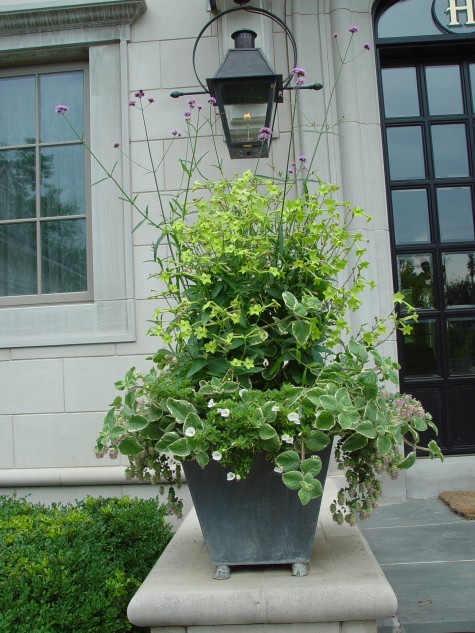 The lime green flowering nicotiana alata is one of my favorite flowers. Green flowers-not so ordinary, but eminently satisfying. The tuft of verbena bonariensis at the top loosens up the entire planting. The wide outer border planting of white million bells, green and white plectranthus, and Kent Beauty showy oregano, softens the top edge of the container, and balances the height of the nicotiana and verbena.
The lime green flowering nicotiana alata is one of my favorite flowers. Green flowers-not so ordinary, but eminently satisfying. The tuft of verbena bonariensis at the top loosens up the entire planting. The wide outer border planting of white million bells, green and white plectranthus, and Kent Beauty showy oregano, softens the top edge of the container, and balances the height of the nicotiana and verbena.
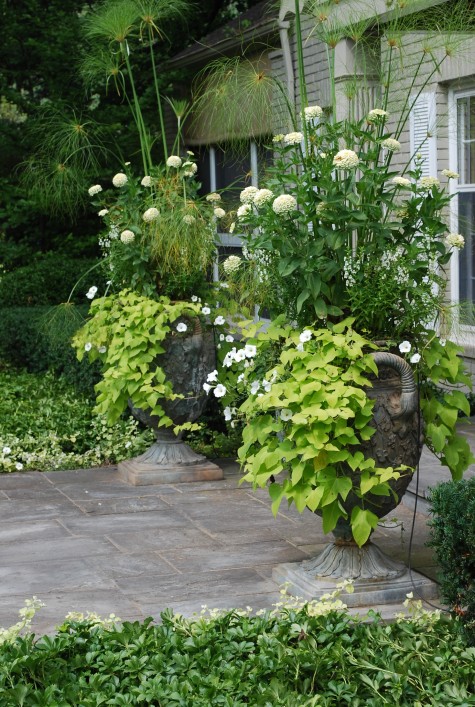 These bronze containers are very intricate, and beautiful. Given that they flank a front door, I plant them tall. The King Tut papyrus provide great height. The tall white zinnias read mostly green. The lime sweet potato vine- they speak strongly to lush. A planting of white mini petunias add some froth where some width is needed.
These bronze containers are very intricate, and beautiful. Given that they flank a front door, I plant them tall. The King Tut papyrus provide great height. The tall white zinnias read mostly green. The lime sweet potato vine- they speak strongly to lush. A planting of white mini petunias add some froth where some width is needed.
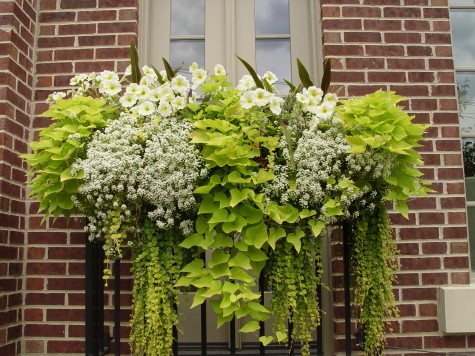
Any predominately green composition gets attention from me on lots of levels. I cannot really explain this-except to say that great color enchants, and distracts me. No doubt beautiful color gets my attention. But when I design, I imagine every element in black and white. Composing containers in green and white is like looking at the natural world in black and white. Black and white-this teaches me plenty.


